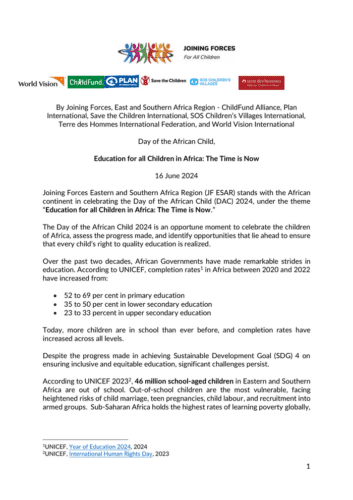Attachments
By Joining Forces, East and Southern Africa Region – ChildFund Alliance, Plan International, Save the Children International, SOS Children’s Villages International, Terre des Hommes International Federation, and World Vision International Day of the African Child, Education for all Children in Africa: The Time is Now
16 June 2024
Joining Forces Eastern and Southern Africa Region (JF ESAR) stands with the African continent in celebrating the Day of the African Child (DAC) 2024, under the theme “Education for all Children in Africa: The Time is Now.” The Day of the African Child 2024 is an opportune moment to celebrate the children of Africa, assess the progress made, and identify opportunities that lie ahead to ensure that every child’s right to quality education is realized.
Over the past two decades, African Governments have made remarkable strides in education. According to UNICEF, completion rates in Africa between 2020 and 2022 have increased from:
• 52 to 69 per cent in primary education • 35 to 50 per cent in lower secondary education • 23 to 33 percent in upper secondary education Today, more children are in school than ever before, and completion rates have increased across all levels.
Despite the progress made in achieving Sustainable Development Goal (SDG) 4 on ensuring inclusive and equitable education, significant challenges persist.
According to UNICEF 2023, 46 million school-aged children in Eastern and Southern Africa are out of school. Out-of-school children are the most vulnerable, facing heightened risks of child marriage, teen pregnancies, child labour, and recruitment into armed groups. Sub-Saharan Africa holds the highest rates of learning poverty globally, with 9 out of 10 children unable to read and understand a simple story by the age of 10
The most vulnerable are children affected by conflict, climate emergencies and children with disabilities. Let us not lose a generation of children due to conflict.
With every displacement, dreams and childhoods are lost. Such is the case with refugee and internally displaced children, where education is disrupted because children constantly need to flee.
We need to sound the alarm on the dire situation in Sudan:
• More than 4 million children are displaced since the start of the conflict making Sudan the world’s largest child displacement crisis.
• Nearly 14 million children, or 50% of the children, need humanitarian assistance.
• More than 90 per cent of the country’s 19 million school-age children have no access to a formal education. This is one of the worst education crises in the world. Additionally, many school buildings are still being used as shelters.
• 17.7 million people – over a third of the population – are acutely food insecure (IPC Phase 3 and above), including about 4.9 million who are experiencing emergency levels of food insecurity.
Conflict and climate-induced emergencies have accelerated the regional learning crisis, displacing millions of children and driving them out of school. There is need to ensure equitable and inclusive access to education for all children. “I hope for the conflict to end so that I can go back to school and continue my education to become a medical doctor. I call on all aid agencies to increase food aid for IDPs especially children who suffer from malnutrition and the old people,” said 17-year-old Eman, an IDP from Sudan.
The child population in Sub-Saharan Africa is growing rapidly. By 2060, nearly 750 million children will be of school age, placing immense pressure on education systems.
While education is the largest public expenditure in Africa, financing remains insufficient and often ineffective. According to UNESCO, getting all African children in school will require9 9 million additional classrooms to be built (or approximately $100 billion investment), and 9.5 million additional teachers to be recruited and trained.
There is need for increased investment in education while also ensuring the efficient use of resources to reap maximum returns.
Source link : https://reliefweb.int/report/world/joining-forces-east-and-southern-africa-region-education-all-children-africa-time-now
Author :
Publish date : 2024-06-14 18:10:27
Copyright for syndicated content belongs to the linked Source.
